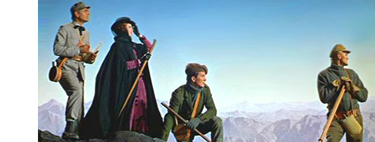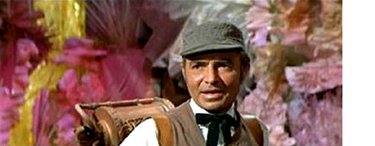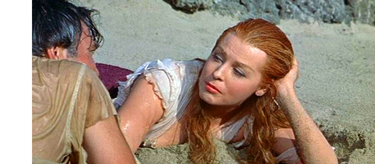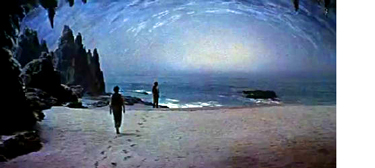
 |
|
|
|
Twilight Time released a dandy Blu-ray of the major childhood favorite Journey to the Center of the Earth just three years ago, but that limited edition run soon sold out. A second go at the title isn't just to make more available for collectors: since then a new 4K restoration has been conducted on this CinemaScope dazzler. Now properly equipped, I'll compare the versions later in the review. 
20th Fox's 1959 Christmas release is an engaging and amusing foray into big-time adventure. It's also one of those happy accidents in which a major studio created great entertainment from a story that begged to be cheapened. For that we can thank Walt Disney's uncompromised adaptation of 20,000 Leagues Under the Sea, which set the standard for high-budget Jules Verne fantasies. Producer Charles Brackett signed up Disney's Captain Nemo, James Mason and surrounded him with a capable cast that included teen crooner Pat Boone, who is not at all bad. Best of all, the adroit sense of humor in Brackett's script maintains a reasonable level of seriousness while allowing tongue-in-cheek tone. The result is fantastic escapism with something for everyone. Verne's story proposes the existence of a vast prehistoric world existing beneath our feet. A mysterious volcanic rock leads freshly knighted professor Oliver Lindenbrook (James Mason) to Iceland to seek Arne Saknussem's secret trail to the center of the Earth. Braving a rival who tries to steal his expedition and a haughty, duplicitous Saknussem heir (Thayer David), Lindenbrook goes bravely forward into the unknown, accompanied by his protégée Alec McEwen (Pat Boone), guide Hans Belker (Peter Ronson) and the widow of his rival, the redheaded, single-minded Mrs. Carla Goeteborg (Arlene Dahl). 
When searching Verne properties to exploit, Journey to the Center of the Earth must have seemed a risky proposition. Nobody had touched the tale since a long-lost silent Spanish version, and previous spelunking adventures hadn't really caught on as movie subject matter. Except perhaps for Tom Sawyer and Becky Thatcher's spooky cave experience in the 1938 Tom Sawyer stories set inside the Earth were of the forgettable kind: Superman and the Mole Men, The Night the World Exploded. The show that came closest to borrowing the Verne concept was 1951's Unknown World, a sober but forgotten adventure about a vehicle called a Cyclotram. Drilling its way into the Earth's mantle, it finds... essentially nothing. 1
Jules Verne's fanciful prehistoric world still thriving at the core of our planet is a concept that doesn't mesh well with 20th-Century science. The best decision by producer Charles Brackett (Billy Wilder's ex-partner) was to retain the original's 19th-Century period trappings. George Pal found success updating H.G. Wells' War of the Worlds, but Verne's antique tales are rooted in 19th century whimsy -- Nemo's Nautilus would pale next to the real, atomic version already in service in 1959. With the story firmly rooted in the fantastic, the biggest problems are neatly sidestepped with enthusiastic silly-science. Verne's inner Earth isn't a furnace of molten rock. Our explorers encounter fresh air, surface gravity and pressure,
Journey to the Center of the Earth compensates for its lack of scientific accuracy with Adventure with a capital A, the kind that finds brave souls stepping off into the unknown with no reasonable expectation of coming back alive. It's the daring spirit that the great explorers and even Conquistadores must have shared: life is short, cities are dirty and work is dull, so why not go for broke and risk all on a mad quest? The Scots and Icelandic explorers may argue over provisions and double-dealing, but all respond to the challenge of adventure, even the dastardly villain. 
Journey to the Center of the Earth carefully prepares us for its fantasy, something modern films no longer have patience for. By the time they descend into the crater below Scartarus, our characters are firmly established. Pat Boone is an uncomplicated fellow with a girl left behind in Edinburgh (the underused, terrific Diane Baker of Strait-Jacket and Silence of the Lambs). Peter Ronson is the non-macho strong man and climbing expert (in real life as well, a nice touch). He's given a pet duck named Gertrud as a fob to the Disney audience. Ronson provides needed balance against Boone's persistent singing and rosy-cheeked optimism ("Hi Hi! Professor!"). 
James Mason's respected professor Lindenbrook sputters and throws the occasional tantrum. But he also beams like a five year-old at new discoveries and dances a jig upon hearing good news. Mason holds the picture together with his commanding voice, which smoothes over the roughest episodes. When the center of the globe turns out to be a wholly illogical whirlpool in a wholly illogical ocean (which direction is UP?), we're distracted by a cutaway to Diane Baker back up top and diverted by expertly delivered dialogue. Mason treats his line, "This is it! The magnetic center of the Earth!" as beautifully as his, "Matters of this sort are best settled from a great height" from North By Northwest. The writers make an excellent case for bringing the requisite 'woman' along for what was originally an all-male safari into a hole in the ground. Ex-MGM beauty Arlene Dahl was best known for some spectacular redheaded close-ups in other people's musicals. Her character's sense of dignity helps convey a convincing period setting. The engaging banter between the widow and her dead husband's rival is given its due instead of being used as filler. A real romance builds, along with our affection for all the adventurers, something rare in movies of this kind. And of course, every movie with dinosaurs at the center of the earth, needs a woman to scream at them. 
The sense of class and balance in the light mood of Journey to the Center of the Earth compares well with the later Spielberg Indiana Jones movies, one of which borrows Earth's giant rolling rock gag. But most new action adventures tend to run fast and stupid, impatient for anything but a shorthand beeline to 'the good stuff.' When a Spielberg-era thrill ride movie is over, we indeed feel as if we're being hustled out of the carnival tent to make way for the next batch of suckers. This old Fox film is more satisfying. It has a feeling of substance, even with an ending that wraps things up with the convenience of a ride on an express elevator out of Alice's rabbit-hole -- itself swiped for yet another Indiana Jones movie. The final clincher, and a main reason why Journey keeps its sparkle, is the thunderous score by Bernard Herrmann. Away from the picture it's a tad repetitive, but in context it brings to life every facet of the journey, even when the scenery edges toward the phony side. Journey, like Brackett & Herrmann's earlier Garden of Evil, is a 'music & landscape' picture -- his staccato rhythms lend the western the flavor of a fantasy film. Here the music is a dynamic dirge, sinking ever deeper, lower. In the original 4- track stereo release, and here on this lossless HD track, the opening chords dip lower and heavier, and still lower -- making one's stomach rumble like SenSurround! |
|||||||||||||||||||
Review Staff | About DVD Talk | Newsletter Subscribe | Join DVD Talk Forum
Copyright © MH Sub I, LLC dba Internet Brands. | Privacy Policy
Subscribe to DVDTalk's Newsletters
|